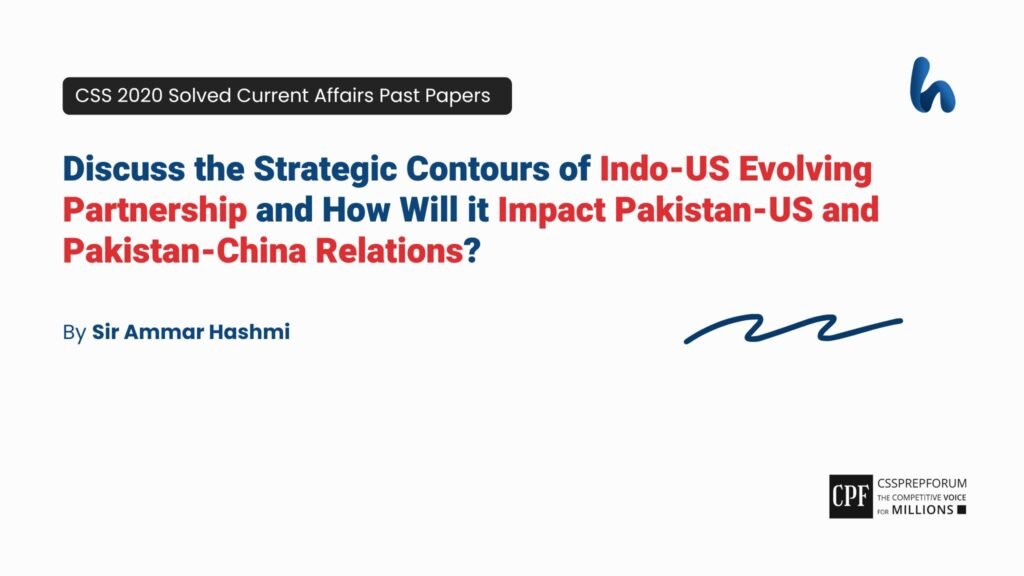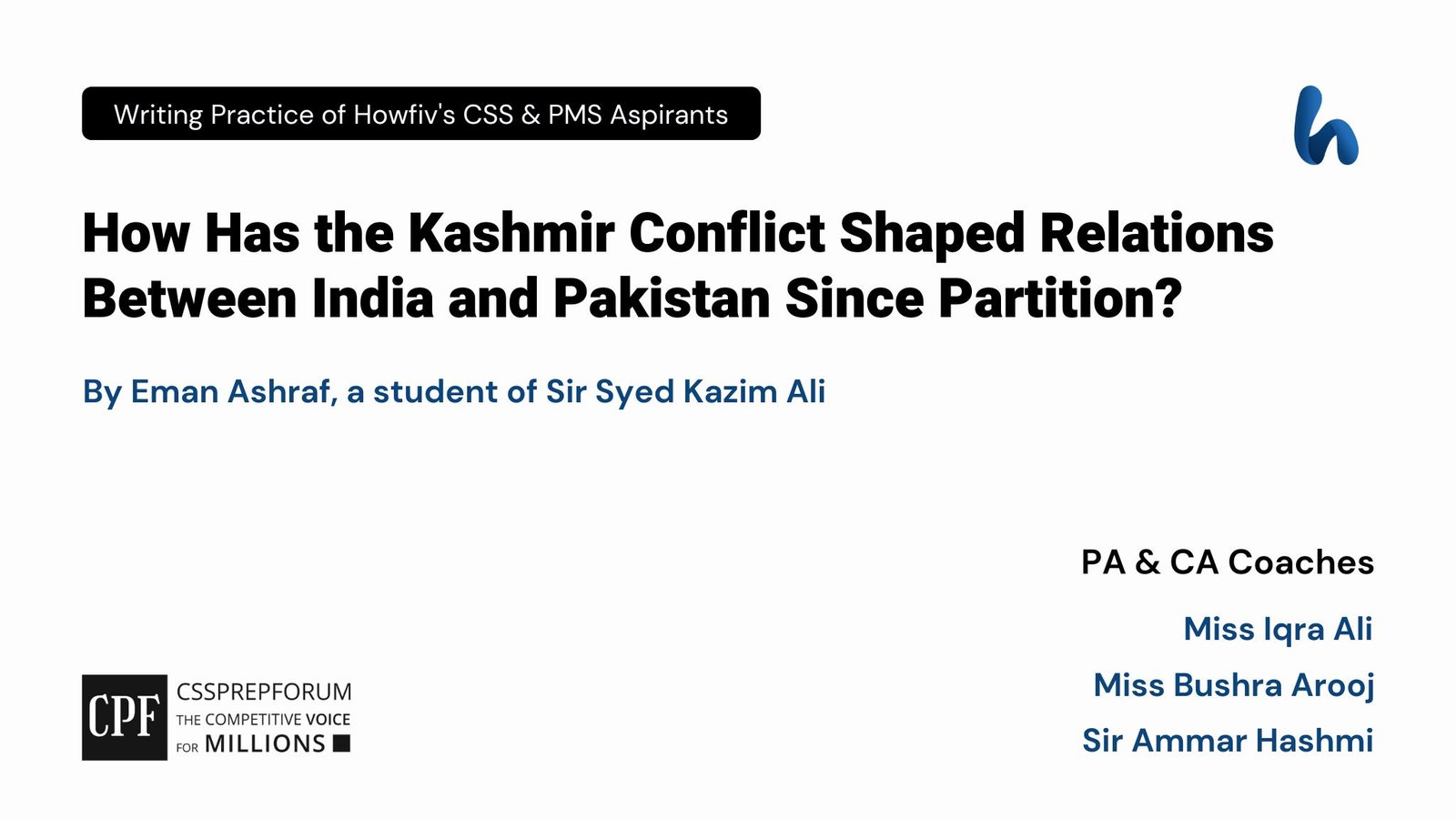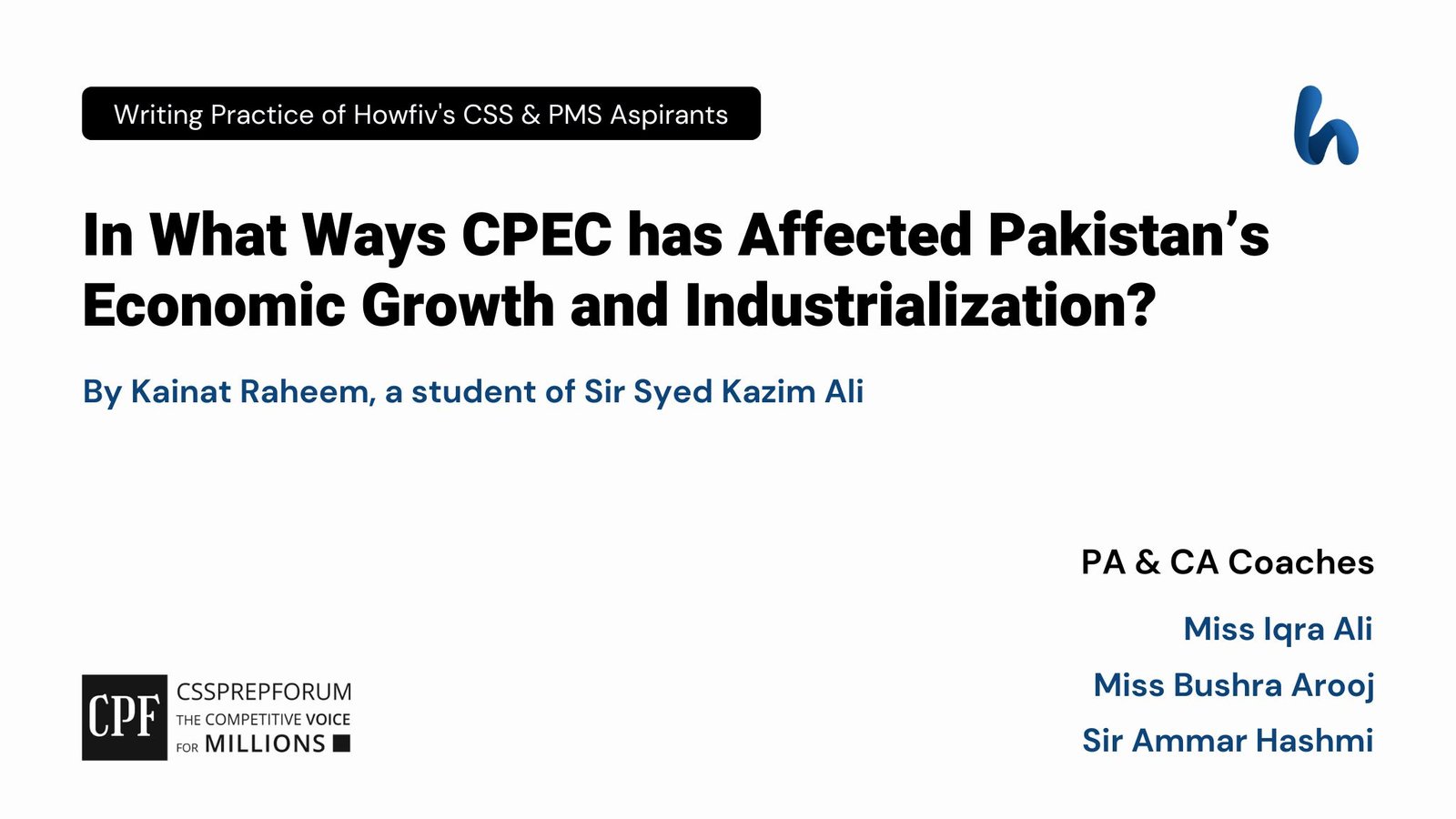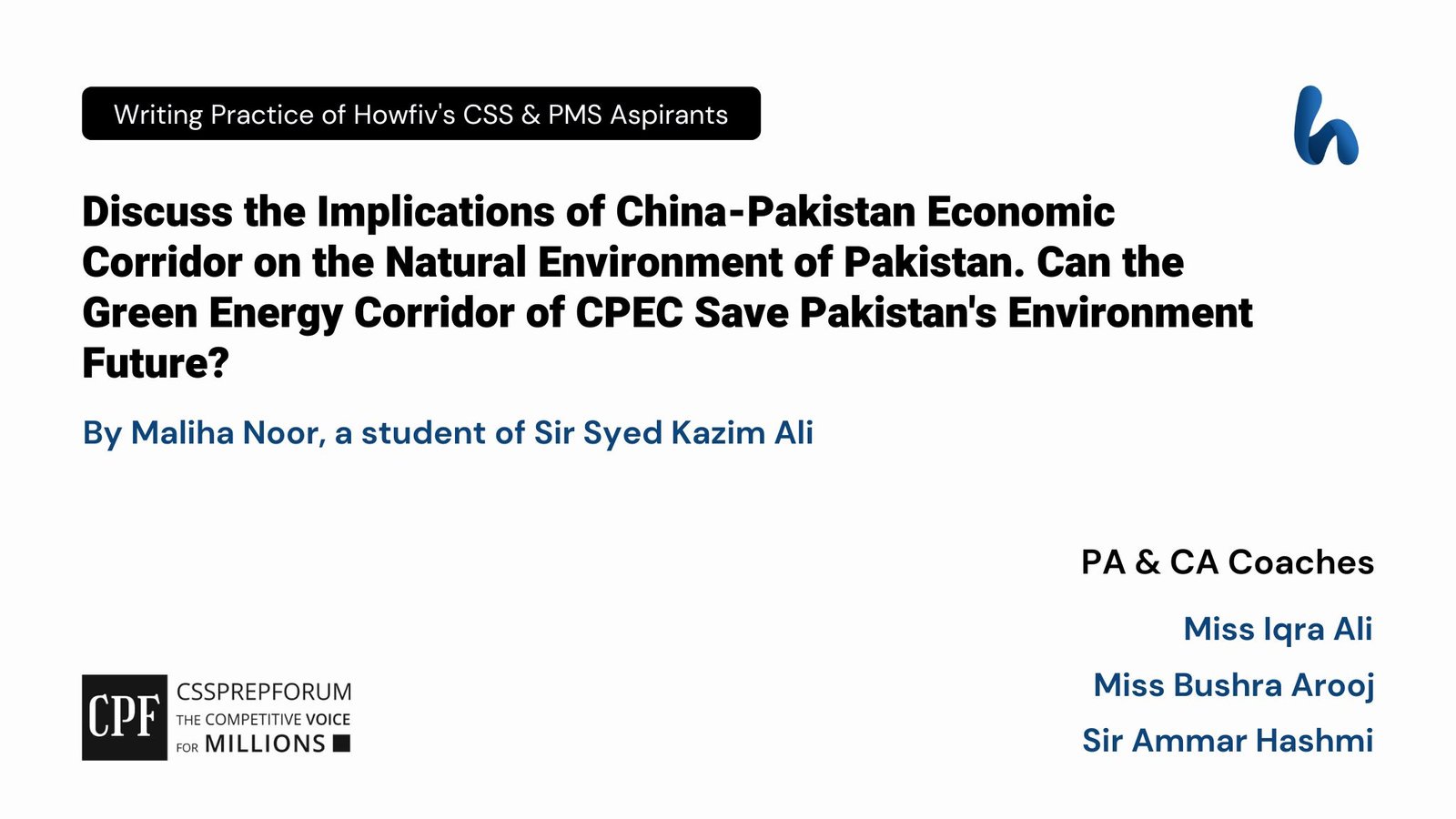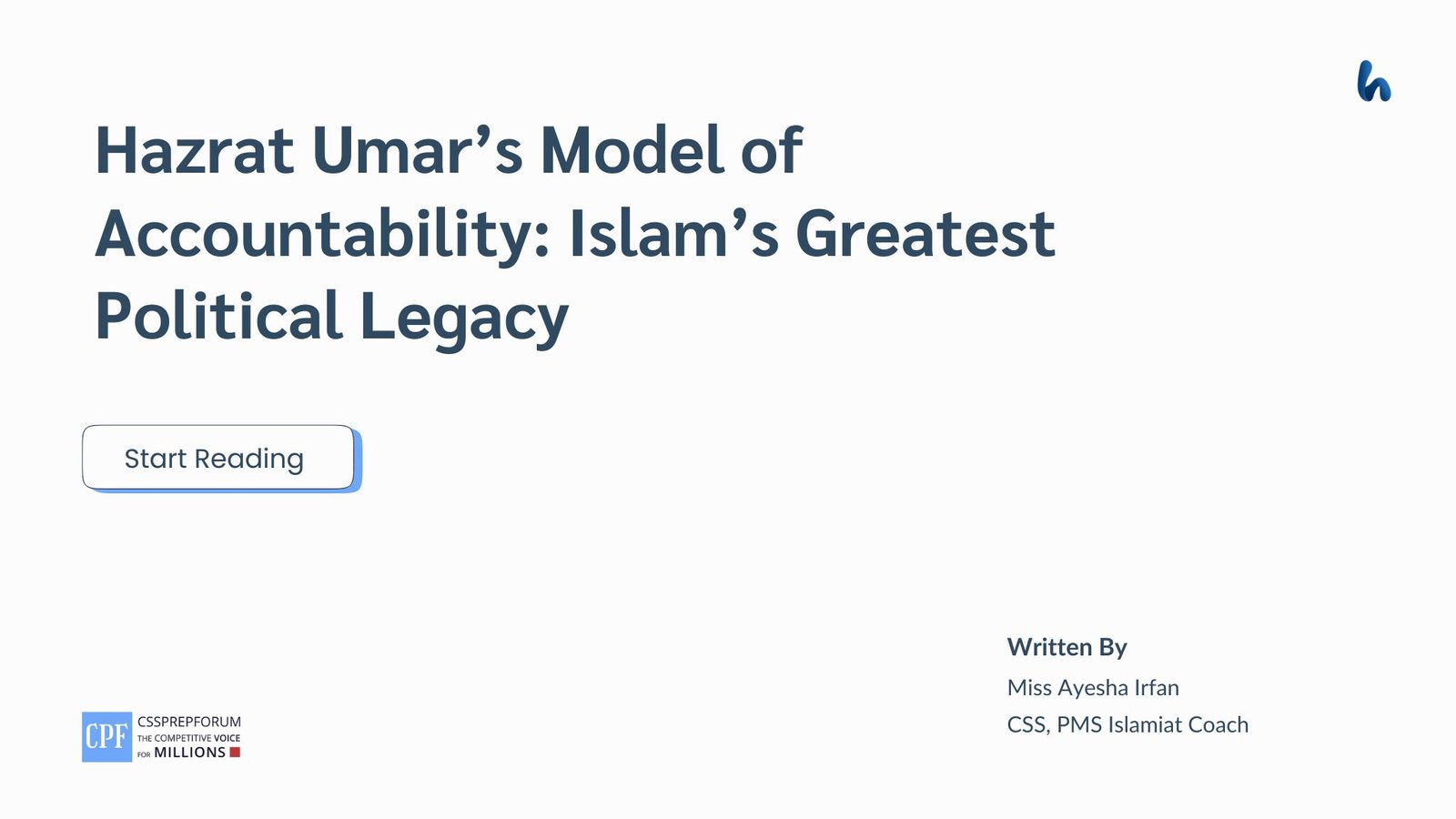CSS 2020 Solved Current Affairs Past Papers | Indo-US Partnership and its Impacts on Pakistan
The following question of CSS Current Affairs 2020 is solved by Sir Ammar Hashmi, the best Current Affairs Coach, on the guided pattern of Sir Syed Kazim Ali, which he taught to his students, scoring the highest marks in compulsory subjects for years. This solved past paper question is uploaded to help aspirants understand how to crack a topic or question, how to write relevantly, what coherence is, and how to include and connect ideas, opinions, and suggestions to score the maximum.

Question Breakdown
The following question underpins the US-India strategic relations and their impact on Pak-china and Pak-US relations
Outline
1-Introduction
2-Understanding US-India relations
3-Deciphering the strategic contours of US-India relations
4-Fundamental strategic agreements between the US and India
- ✓ Logistics Exchange Memorandum of Agreement (LEMOA) in 2016
- ✓ Communications Compatibility and Security Agreements (COMCASA) in 2018
- ✓ Basic Exchange and Cooperation Agreement (BECA) in 2020
- ✓ US-India initiative on Critical and Emerging Technology (iCET) in 2023
- ✓Expanding Bilateral trade
5-Implications of US-India strategic partnership on Pak-US and Pak-China relations
6-Future of Pak-US relations in the context of growing US-India relations
- ✓US focus towards indo-Pacific
- ✓ Sanctions on Pakistan Missile system
- ✓US shift on Kashmir policy
7-Prospects for Pakistan-China relations
- ✓Rejuvenating Pakistan defense sector
- ✓Technological partnership
- ✓Trade and economics
8-Critical analysis
9-Conclusion

Answer to the Question
Introduction
The US-India strategic relations are actually a marriage of convenience based on mutual interest in the Indo-Pacific Ocean region. Both the US and India have a shared goal of containing China’s influence in the region. In addition, India has intentions to emerge as a regional power. To pursue mutual interests, both countries have signed numerous bilateral agreements, like LEMAO, BECA and iCET. Nonetheless, the prevailing strategic relations between the US and India have a profound impact on Pakistan’s relations with China and the US. For instance, US-India relations have yielded significant prospects for Pakistan and China to strengthen bilateral cooperation at multiple levels, including the Pakistan Economic Corridor CEPAC, the Belt and Road (BRI) initiative and the Shanghai Cooperation Organization (SCO) . Ironically, it has grieved implications for Pakistan-US relations, as it has widened the gap between the two countries as evident from the US geopolitical shift towards India
Understanding US-India relations
The US-India strategic partnership has gained tremendous momentum over the past two decades. Historically, because of lacking mutual interests and the non-alignment policy of India, the two countries have not been strategically so aligned as of today. However, following the fall of the Soviet Union, India’s adaptation of free trade policies and the emergence of China as a threat to the regional and global hegemony of the United States have shrunken the gap between the two countries. For sure, the large market status of India and its strategic importance as an anchor of security in the Indo-Pacific region against China’s influence have catalyzed the convergence in US-India relations. Similarly, the regional hegemonic tendencies of India, accompanied by the US interests to tackle China’s dominance, have reinforced the establishment of a strategic partnership between the two countries. So far, multiple bilateral agreements have been signed between the two countries to achieve mutual interests, such as LEMOA, COMSCA, BECA and iCET.
Deciphering the strategic contours of US-India relations
The US-India relations underscore multifaceted contours, ranging from bilateral defence agreements to cooperation in technological advancement and expanding trade between the two countries.
Bilateral strategic agreements between the US and India
To achieve national interests, and to reinforce strategic partnership countering the rise of china in the Indo-pacific region, the US and India have signed multiple bilateral agreements. Primarily, these agreements are focused on enhancing the security potential of both countries through exchange of data, combine military exercises and access to military facilities of each other. Here’s a quick glance of these bilateral agreements.
- Logistics Exchange Memorandum of Agreement (LEMOA) in 2016
The Logistics Exchange Memorandum of Agreement (LEMOA), signed between the US and India in 2016, is a significant milestone for enhancing defence cooperation between the two countries. According to the terms and conditions of the agreement, the two countries will have access to the military facilities of each other for the purpose of logistical support. Similarly, the agreement underscores joint exercises, port calls and naval forces cooperation in the Indo-pacific and the Indian Ocean region. Certainly, the unprecedented support and cooperation between the two countries will strengthen the defense mechanism of both countries. Further, with access to facilities and bases around China, the agreement will boost the naval capabilities of India to counter the Chinese strategy of “string of pearls” in the Indian Ocean region.
- Communications Compatibility and Security Agreements (COMCASA) in 2018
The US and India have signed the Communications Compatibility and Security Agreement (COMCASA) in 2018 on sideline with 2+2 security dialogue between the two countries. The agreement has granted Indian military access to the US data bank and high-end secured and encrypted security system. In addition, the agreement has legally allowed the transfer of security system installed in the US to India. Thus, access to the US communication and defence platforms will enhance the security capabilities of Indian defence.
- Basic Exchange and Cooperation Agreement (BECA) in 2020
The US and India, carrying the confidence of bilateral strategic partnership, have signed the Basic Exchange and Cooperation Agreement in 2020 to further strengthen the security apparatus and coordination between the two countries. The BECA agreement facilitates intelligence sharing between the Indian Ministry of Defense and the National Geospatial-Intelligence Agency of the US Department of State. Additionally, the agreement provides Indian military access to aeronautical and topographical data of the US, which will further improve the accuracy of the Indian defence system. Similarly, access to the geospatial agency will further increase the accuracy of aeronautical drones.
- US-India Initiative on Critical and Emerging Technology (iCET) in 2022
The US-India initiative on Critical and Emerging Technology (iCET) encompasses various avenues for technological collaboration. To illustrate, the initiative fosters research partnerships between the National Science Foundation and Indian science agencies in the fields of quantum technologies, Bio-technology and Artificial Intelligence. In addition, the initiative facilitates the training of Indian Space Research Organization (ISRO) astronauts at the National Aeronautics and Space Administration (NASA) Johnson Space Center. Moreover, the initiative encourages collaboration on designing and manufacturing semiconductors to establish a resilient global supply chain.
- Expanding bilateral trade
Furthermore, the expanding bilateral trade between the US and India has a pivotal role in nourishing the strategic relations between the two countries. Certainly, the freed trade policies of both countries and India as a large market to US exports are the main forces behind expanding bilateral trade. In addition, mutual strategic interests have further fueled bilateral trade between the two countries. According to the provisional data of the Indian Commerce Ministry, the bilateral trade between India and the US increased by 7.65% to US$ 128.55 in 2022-23 as against US$ 119.48 billion in 2021-22. Moreover, the Strategic Trade Authorization-1 (STA-1) status granted by the US to India has further paved the way for high-technology trade between the two countries. Importantly, the authority granted to India, being the first South Asian country, manifests the strategic bonding between the two countries.
Implications of US-India strategic partnership on Pak-US and Pak-China relations
A-Future of Pak-US relations in the context of growing US-India relations
The growing strategic relations between the US and India have grieved implications for Pakistan-US relations. However, the US, being a global power, cannot undermine the geographic importance of Pakistan to balance Chinese interests. The following points show the divergence in Pak-US relations.
- US focus towards indo-Pacific
Pakistan had been a key ally of the US in the war against terrorism. However, the US has shifted its focus towards the Indo-Pacific, underscoring India as a major partner and undermining Pakistan’s efforts for regional stability and counter-terrorism. Likewise, the absence of Pakistan in the recent US National Security Strategy (NSS) has widened the gap between the two countries
- Sanctions on Pakistan Missile System
Despite being a close ally in counter-terrorism objectives, the US has recently imposed sanctions on suppliers to Pakistan’s Ballistic Missile system, reiterating it against American interests. However, on the other side, the US is working for India’s nuclear advancement. Moreover, the US had recently suspended the Coalition Support Fund to Pakistan, alleging the country’s inability to combat terrorism. The prejudiced response to two neighbours reflects the rift in Pak-US relations.
- US shift on Kashmir policy
The US, being a global power, has shifted its policy on Kashmir, reinforcing it as a territorial dispute between Pakistan and India. According to the US State Department, the Kashmir issue is a territorial conflict between the two neighbours, which should be solved through bilateral dialogue according to the will of Kashmiris. Ironically, the shift from such a historical conflict reiterating it a bilateral issue underscores the US led favorable conditions for India.
B-Pakistan-China relations in the realm of growing strategic cooperation between India and The US
The changing geopolitical dynamics, specifically the strategic tilt of the US towards India has paved the way for Pakistan and China to strengthen their bilateral relations, multifacetedly. Here are the contours of strengthening Pak-China relation strategic relations.
- Rejuvenating Pakistan’s defence sector
In the pursuit of growing cooperation, china has helped Pakistan boost its defence sector. For instance, the country has played a vital role in Pakistan’s nuclear weaponization program. Despite US sanctions, it has been working with Pakistan in the development of a solid propellant missile system. According to the US Institute of Peace, Pakistan imports 40 per cent of its arms from China, reinforcing mutual trust and strategic partnerships. Additionally, on the naval grounds, the two countries have been jointly conducting “Sea Guardian” exercises in the Indian Ocean
- Technological partnership
The two countries are vibrantly engaged in technological cooperation with each other. Recently, both countries have launched a joint lunar mission, ICUBE-Qamar, in May 2024. Besides, under the flagship of China-Pakistan Economic Corridor (CPEC), both countries have established China-Pakistan Joint Research Center on Earth Sciences (CPJRC). In addition, Pakistan has been using the China-based BeiDuo Navigation System (BDS) since 2018 for surveillance and navigation purposes.
- Trade and economics
China has been the largest trading partner and foreign investor in Pakistan. Both countries have signed the China-Pakistan Free Trade Agreement (FPTA) to enhance bilateral trade. Similarly, under the flagship of the Belt and Road Initiative (BRI), the China-Pakistan Economic Corridor (CPEC) has been initiated by the two countries, enhancing regional connectivity and trans-regional trade. In the first phase of CPEC, china has invested 25.4 billion dollars primarily on enhancing transport infrastructure and energy sector.
Critical analysis
The strengthening of US-India strategic relations has restructured the contours of geopolitics in South Asia. Having multiple bilateral defence, trade and technological agreements, the strategic ties have a shared goal of destabilizing China’s influence in the region. For sure, the anticipated power imbalance in the Indo-Pacific due to Indo-US strategic relations has many implications for regional stability. Like, the militarization of the region can forge an arms race to maintain minimum deterrence. Similarly, the growing relations can destabilize regional relations, paving the way for new alliances to maintain strategic stability.
Conclusion
In a nutshell, the US-India strategic ties expand on multiple fronts. Ranging from trade and technology to multiple defence agreements, the ties have a significant impact on regional strategic contours. Like, the ties have catalyzed the convergence and divergence in regional relations. The shift can be seen in the widening gap in Pak-US and augmenting Pak-China relations. Besides, the Indo-US strategic relations are the precursor for forging a trade war in the Indo-Pacific region.
CSS Solved Past Papers’ Essays
Looking for the last ten years of CSS and PMS Solved Essays and want to know how Sir Kazim’s students write and score the highest marks in the essays’ papers? Then, click on the CSS Solved Essays to start reading them.
CSS Solved Essays
CSS Solved General Science & Ability Past Papers
Want to read the last ten years’ General Science & Ability Solved Past Papers to learn how to attempt them and to score high? Let’s click on the link below to read them all freely. All past papers have been solved by Pakistan’s top CSS GSA coach having the highest score of their students.
General Science & Ability Solved Past Papers

